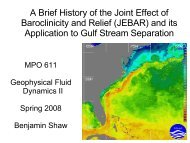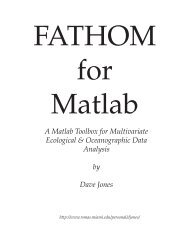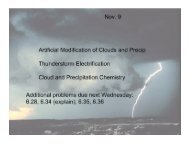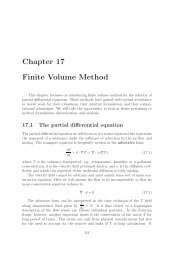2007 (PDF) - Rosenstiel School of Marine and Atmospheric Science ...
2007 (PDF) - Rosenstiel School of Marine and Atmospheric Science ...
2007 (PDF) - Rosenstiel School of Marine and Atmospheric Science ...
Create successful ePaper yourself
Turn your PDF publications into a flip-book with our unique Google optimized e-Paper software.
Earth Dynamics<br />
NASA aircraft preparing for coordinated research flights during TC4 mission in Costa Rica. Photo credit: Sean Davis<br />
Earth to Air<br />
Our lives are affected by the chemistry <strong>and</strong> physics <strong>of</strong> different<br />
parts <strong>of</strong> the atmosphere, which may influence air quality <strong>and</strong><br />
climate. In the lower atmosphere, emissions <strong>of</strong> pollutants from<br />
human activity can interact with naturally occurring chemicals to<br />
have adverse effects on air quality. At higher altitudes <strong>and</strong> near the<br />
equator, chemical <strong>and</strong> physical processes that occur as the result<br />
<strong>of</strong> tropical convection can have a significant impact on climate.<br />
In <strong>2007</strong>, scientists from the <strong>Marine</strong> <strong>and</strong> <strong>Atmospheric</strong> Chemistry<br />
division had the opportunity to study both <strong>of</strong> these atmospheric<br />
regions in coordinated studies with scientists from other universities<br />
<strong>and</strong> government agencies.<br />
Biosphere Effects on Aerosol <strong>and</strong> Photochemistry Experiment<br />
(BEARPEX) was a collaborative field campaign, organized by<br />
Ron Cohen <strong>and</strong> Allen Goldstein at the University <strong>of</strong> California -<br />
Berkeley (UC-Berkeley), that took place in August <strong>and</strong> September<br />
<strong>of</strong> <strong>2007</strong> at UC-Berkeley’s Blodgett Forest Research Station in the<br />
Sierra Nevada Mountains. Drs. Xinrong Ren <strong>and</strong> Elliot Atlas from<br />
the University <strong>of</strong> Miami were part <strong>of</strong> the scientific group making<br />
coordinated measurements <strong>of</strong> atmospheric chemical composition<br />
<strong>and</strong> variation at the site. Among the questions being addressed<br />
were: How do natural emissions from plants interact with the<br />
chemicals in an urban plume to alter the reactivity <strong>of</strong> this mixture?<br />
What happens to chemical reactants during night, when different<br />
chemical processing will occur? What proportion <strong>of</strong> the biogenic<br />
emissions contribute to the formation <strong>of</strong> particles, <strong>and</strong> what influences<br />
<strong>and</strong> determines particle production? What are the ecosystem<br />
<strong>and</strong> environmental variables that control the exchange <strong>of</strong> reactive<br />
atmospheric gases? The results <strong>of</strong> the study (with additional experiments<br />
planned in 2009) will help to clarify potential consequences<br />
<strong>of</strong> future anthropogenic development <strong>and</strong> climate change.<br />
The Tropical Composition, Cloud <strong>and</strong> Climate Coupling Experiment<br />
(TC4), organized by NASA, probed an even more remote region<br />
<strong>of</strong> the atmosphere,<br />
the tropical transition<br />
layer (TTL). An<br />
extremely cold region<br />
located in the tropics<br />
between about 14 – 18<br />
km altitude, this region<br />
<strong>of</strong> the atmosphere<br />
cannot be reached by<br />
conventional research<br />
aircraft, <strong>and</strong> satellites<br />
have trouble seeing<br />
through the <strong>of</strong>ten<br />
dense clouds. Many<br />
facets <strong>of</strong> the chemical,<br />
dynamic <strong>and</strong> physical<br />
Dr. Elliot Atlas <strong>and</strong> Rich Lueb prepare air sampling<br />
equipment to deploy on NASA WB-57 aircraft for<br />
later analysis <strong>of</strong> the chemical composition <strong>of</strong> the<br />
tropical atmosphere. Photo credit: Unknown<br />
processes occurring in the TTL are not well understood. Identifying<br />
<strong>and</strong> quantifying such processes are essential to underst<strong>and</strong>ing<br />
ozone depletion, tropospheric chemistry <strong>and</strong> global warming. The<br />
experiment, utilizing satellite <strong>and</strong> airborne observations, addressed<br />
several questions,<br />
As part <strong>of</strong> the scientific team <strong>of</strong> the WB57 aircraft, the UM team,<br />
led by Atlas, collected air samples from the TTL that were later<br />
analyzed in his laboratory at the <strong>Rosenstiel</strong> <strong>School</strong>. The chemical<br />
composition measurements from these samples formed the basis for<br />
better underst<strong>and</strong>ing <strong>of</strong> the amount <strong>and</strong> composition <strong>of</strong> ozonedepleting<br />
substances that enter the stratosphere, as well as providing<br />
chemical markers that identify the source <strong>of</strong> air masses in this<br />
region <strong>of</strong> the atmosphere.<br />
“Current” Research<br />
Off the Atlantic coast <strong>of</strong> the United States, <strong>Rosenstiel</strong> <strong>School</strong> Co-<br />
Principal Investigators Bill Johns <strong>and</strong> Lisa Beal are working on the<br />
western boundary component <strong>of</strong><br />
the RAPID/MOCHA (Meridional<br />
Overturning Circulation <strong>and</strong><br />
Heatflux Array) effort; a largescale,<br />
highly collaborative program<br />
which measures modes <strong>of</strong> Atlantic<br />
Ocean heat transport from the<br />
equator to the poles. Through<br />
continuous monitoring, the project<br />
will assess the natural shortterm<br />
variability <strong>of</strong> the Meridional<br />
Overturning Circulation, leading<br />
toward an underst<strong>and</strong>ing <strong>of</strong> its role<br />
in rapid climate change.<br />
Dr. Bill Johns dismantling the strobe<br />
from a recovered buoy on a RAPID/<br />
MOCHA cruise aboard the R/V<br />
Seward Johnson. Photo credit: Lisa<br />
Beal<br />
The basin-wide RAPID/MO-<br />
CHA array comprises moorings<br />
from the National Oceanography<br />
Centre in the United Kingdom,<br />
placed over the mid-Atlantic<br />
Dr. Lisa Beal carrying an A<strong>and</strong>eraa Doppler current meter<br />
aboard the R/V Knorr. Photo credit: Unknown<br />
Ridge <strong>and</strong> at the eastern boundary <strong>of</strong> the subtropical Atlantic, just<br />
<strong>of</strong>fshore from North Africa. The University <strong>of</strong> Miami’s team measures<br />
the Antilles Current <strong>and</strong> Deep Western Boundary Current <strong>of</strong>f<br />
Abaco Isl<strong>and</strong>, Bahamas, where moorings are equipped with current<br />
meters <strong>and</strong> microCATs to measure the velocity, temperature, <strong>and</strong><br />
water salinity.<br />
Together with measurements <strong>of</strong> the Florida Current inferred from<br />
submarine cable by NOAA’s Atlantic Oceanic <strong>and</strong> Meteorological<br />
Laboratory, the data capture the 3,000 mile basin-wide Atlantic<br />
Meridional Overturning Circulation (AMOC). Until now the real<br />
variability <strong>of</strong> the AMOC has not been studied, even on shorter<br />
time scales. Because <strong>of</strong> the possible role the AMOC plays in rapid<br />
climate change, measuring <strong>and</strong> underst<strong>and</strong>ing its variability <strong>and</strong><br />
sensitivity to atmospheric forcing has truly become a priority.<br />
There is paleoceanographic evidence <strong>of</strong> rapid climate change events<br />
during the last glacial period that have been linked with variability<br />
in the AMOC. The AMOC can be described as the circulation <strong>of</strong><br />
warmer waters poleward at the surface <strong>of</strong> the ocean, which cool <strong>and</strong><br />
sink, to return to the equator in the deep ocean. Recent evidence<br />
suggests that the AMOC may slow down in response to global<br />
warming, <strong>and</strong> that this could, in turn, rapidly cool northern European<br />
climate by reducing the northerly advection <strong>of</strong> warm surface<br />
waters.<br />
Sarah Woods provides routine<br />
maintenance <strong>of</strong> the CO2 Flux<br />
Tower on the CCGS Amundsen.<br />
Photo credit: Bruce Johnson,<br />
University <strong>of</strong> Manitoba<br />
Breaking Through<br />
Long sought after by early European explorers as a convenient passage between Europe <strong>and</strong> Asia, the<br />
Northwest Passage through the Arctic Ocean has been essentially impassable due to thick sheets <strong>of</strong> sea<br />
ice. Attributed to changes in climate, the pack ice is being reduced <strong>and</strong> this shrinkage is making known<br />
waterways increasingly navigable, as new waterways are being charted for the first time.<br />
As part <strong>of</strong> the <strong>2007</strong>-2009 International Polar Year (IPY) research program to investigate global climate<br />
change in the Arctic, Sarah Woods, a Ph.D. student under the supervision <strong>of</strong> Dr. Darek Bogucki in the<br />
division <strong>of</strong> Applied <strong>Marine</strong> Physics, embarked on a six-week scientific cruise through the Northwest Passage.<br />
Woods, who joined the scientific cruise in October <strong>2007</strong> in Resolute, Nunavut, Canada was among<br />
the 40 scientists, students <strong>and</strong> crew members following in the trail blazed by Norwegian explorer Roald<br />
Amundsen in 1906.<br />
Aboard the aptly named Canadian icebreaker, the CCGS Amundsen, Woods<br />
participated in ArcticNet <strong>and</strong> the Circumpolar Flaw Lead Study (CFL), two<br />
studies investigating the changing Arctic climate <strong>and</strong> its impacts on local communities.<br />
The ship will be at sea for the entire year, with scientists, students,<br />
<strong>and</strong> crew rotating on <strong>and</strong> <strong>of</strong>f. As part <strong>of</strong> a NASA-funded project, “Estimates<br />
<strong>of</strong> Arctic air-sea CO2 transfer using QuikSCAT scatterometer,” Woods is collecting<br />
data to measure air-sea CO2 transfer, <strong>and</strong> measurements <strong>of</strong> mean<br />
square wave slope in order to derive estimates <strong>of</strong> arctic air-sea CO2 transfer<br />
from QuikSCAT measurements.<br />
The IPY will involve more than 200 projects, with thous<strong>and</strong>s <strong>of</strong> scientists from<br />
over 60 nations examining physical, chemical, biological <strong>and</strong> social science<br />
research topics. <strong>Rosenstiel</strong> <strong>School</strong> faculty member, Dr. William Drennan <strong>and</strong><br />
Ph.D. student Silvia Gremes-Cordero plan to board the ship in summer 2008.<br />
Early morning view <strong>of</strong> a small ice lead in the Canadian<br />
Archipelago, near Paulatuk, Northwest Territories.<br />
Photo credit: Sarah Woods<br />
11<br />
12




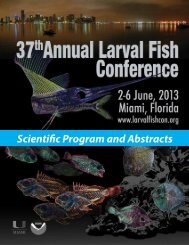
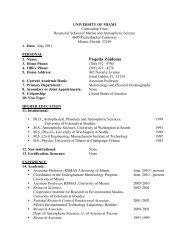
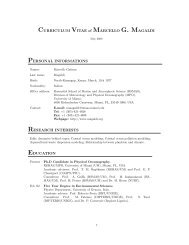
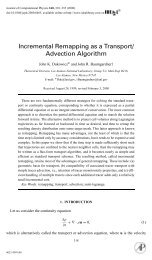
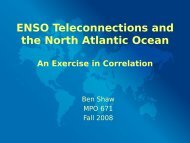
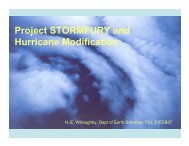
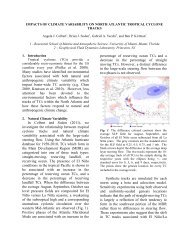

![Wavelength [μm] ZENITH ATMOSPHERIC TRANSMITTANCE](https://img.yumpu.com/26864082/1/190x143/wavelength-i-1-4-m-zenith-atmospheric-transmittance.jpg?quality=85)
